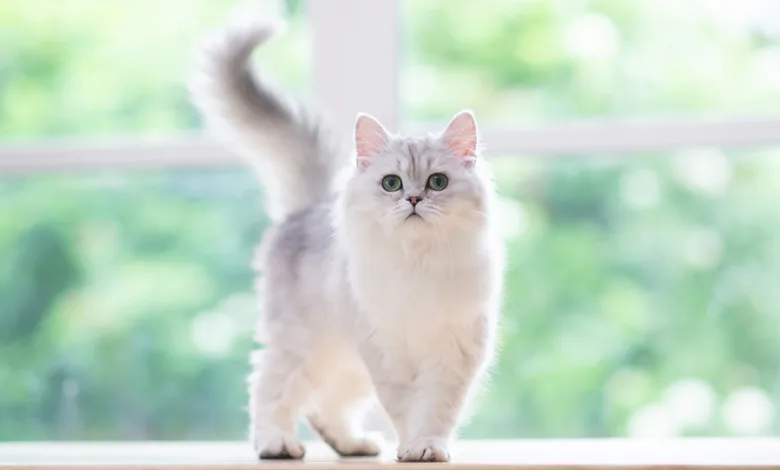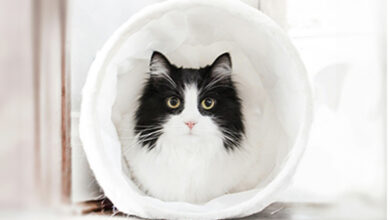Understanding Your Cat’s Behavior

What does it mean when your furry feline friend puffs its tail? What’s the best way to handle your cat’s neuroticism? Why is your kitty scratching up all your furniture?
Cats have darn good reasons for most of their behaviors. The simple trick to prevent or remedy problems? Better understand your cat.
A Cat’s Five Personality Traits
Like humans, every cat has a combination of traits making up its unique personality. Researchers from the University of Australia identified what they call the “Feline Five…: dominance, agreeableness, extraversion, impulsiveness, and neuroticism.
Dominant
Dominant cats tend to bully or act aggressively toward other cats. Discourage young kittens from grabbing or biting you or playing aggressively to prevent it from growing into a dominant cat. Feed multiple cats in separate areas to reduce competition. Also, give your cats equal time with you to reduce the possibility of jealousy. When your cats play together nicely, reinforce this behavior with plenty of praise, petting, and treats.
Agreeable
Agreeable cats are gentle, friendly, and affectionate toward people. But even an agreeable cat can have its drawbacks. Because of their friendly, affectionate nature, an agreeable cat might often paw at you for attention. If so, set up a routine for cuddling, which might help. Also, consider adopting an additional cat to keep your cat company ª make sure it’s not too dominant.
Extraverted
Extraverted cats possess self-control. They are decisive and perseverant. But they tend to get bored easily and need plenty of stimulation. Extraverted cats should have plenty of toys, human interaction, and, perhaps, other cats with whom to play and socialize.
Impulsive
Impulsive cats tend to be erratic and reckless. This often results from a stressful environment. Factors that can cause your cat stress include other pets in the home, young children, confinement, or lack of access to hiding places or a litter box. Even insisting on interaction with your cat can be stressful if it’s more interaction than your cat wants.
Neurotic
Neurotic cats can be fearful of people, anxious, insecure, suspicious, or shy. Offer these cats additional hiding places and quiet spaces.

How to Understand Some Common Cat Behaviors
Here are some common signals and behaviors every cat owner should understand.
Feline Vocalization
When your cat meows, it’s usually asking for something ª or could just be saying “hello.… The more frequent and intense the meow, the more intent your cat is for you to respond. If the meowing is continuous, particularly after trying to satisfy your cat’s needs, your feline may be sick or injured and may need a veterinarian’s attention.
Nonstop yowling can also be a sign of discomfort or illness. Cats yowl out of worry when their territory is threatened. Or they may simply want to mate.
Some cats even yowl when they’re bored. Since cats are nocturnal, combat this by helping your cat adjust to a nighttime sleep schedule. Keep your cat awake more during the day, particularly in the evening before bedtime.
Purring usually signifies contentment, though it could also suggest worry. You can decipher the meaning by looking at your cat’s body language: Tense posture and ears laid back most likely indicate worry.
Hissing, snarling, or growling is a clear warning to back off. When a cat feels threatened, it might scratch or bite. So, remove the threat (such as your playful puppy or toddler) immediately.
The Tell-Tale Tail
Cats’ tail movements say a lot about what they’re thinking or feeling.
When a cat sweeps its tail widely, it’s annoyed or wants to be left alone. If a cat becomes very agitated or frightened, its tail movement is intensified, sweeping back and forth rapidly. Either cue indicates the cat wants to be left alone. The latter signal also indicates it’s ready to flee or attack.
Cats’ tails can puff up for several reasons. A puffed tail with ears erect and whiskers pointed forward usually means the cat’s happy or having fun.
When a bristled tail points straight up or down, possibly coinciding with an arched back and flattened ears, the cat is fearful.
When the fur on a cat’s entire body puffs up, the cat is very angry and might even hiss. Cats sometimes do this to intimidate. But it can also mean an attack is imminent.
Destructive Claws
If your cat still has its claws, you’ve probably dealt with the frustration of snagged upholstery, carpet, or drapes. But this is instinctive behavior: It’s kind of like a kitty manicure. Cats do this to shed the dead frayed layers and sharpen their claws. It’s also one way that cats mark their territory. And it’s a natural part of feline play and stretching.
To combat the problem, give your cat a scratching post. You might need to try a variety of shapes, upholsteries, and other characteristics. Also, keep your cat’s claws trimmed. When your cat does scratch on other objects, clap loudly so the cat stops.
The American Association of Feline Practitioners recommends against declawing. The procedure is invasive and can result in infection and extended pain during recovery.
Hopefully this insight into personality types and the reasoning behind some common behaviors will help you better understand your cat’s actions.





